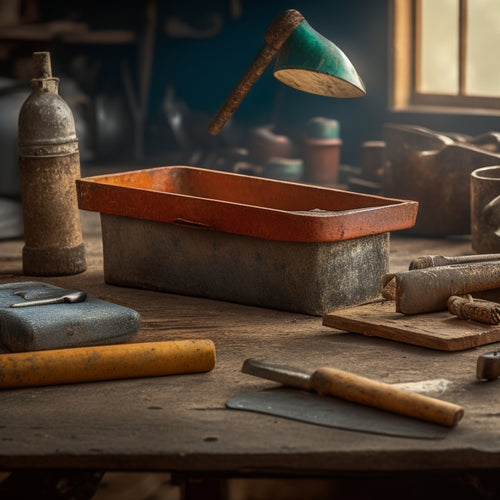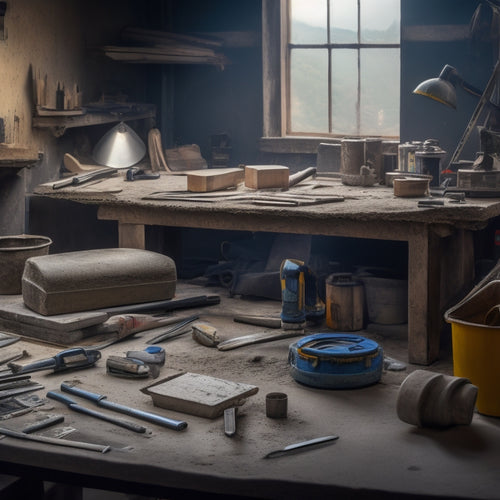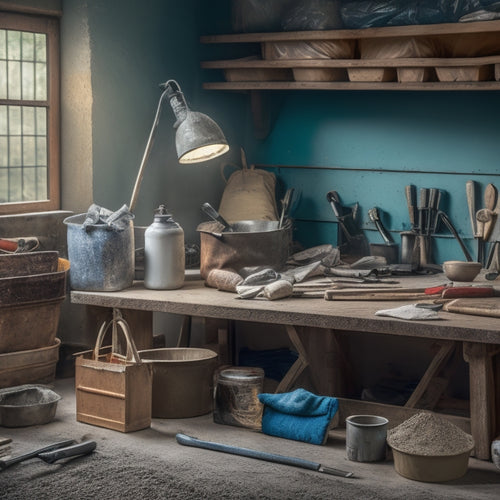
Essential Tools for DIY Concrete Masonry Projects
Share
As you prepare for your DIY concrete masonry project, it's vital to have the right tools to achieve professional-looking results. You'll need cinder block laying essentials like a spirit level and trowel, as well as mixing concrete tools like a reliable mixer and measurement tools. Don't forget block cutting and shaping tools, mortar and grout application tools, and leveling and aligning tools. Safety gear, measuring and marking tools, and finishing and sealing tools are also important. With these essentials, you'll be well-equipped to tackle your project. Now, get ready to learn how to put them to use and release your DIY potential.
Key Takeaways
• Essential tools for DIY concrete masonry projects include spirit levels, trowels, jointers, mixers, and safety gear to ensure durability and precision.
• Cinder blocks come in regular, insulated, and decorative types, each with unique benefits and uses in concrete masonry projects.
• Mixing concrete requires a proper ratio of cement to aggregate, reliable mixing equipment, and protective gear to ensure strength and safety.
• Concrete pouring equipment, such as wheelbarrows and pouring buckets, helps achieve a smooth and even pour with minimal defects.
• Specialized tools, like diamond blade saws and block chisels, are necessary for cutting, shaping, and refining concrete blocks to achieve complex designs.
Cinder Block Laying Essentials
Before laying the first cinder block, you'll need to gather essential tools and materials, including a spirit level, trowel, jointer, and a sufficient supply of mortar and blocks.
There are various cinder block types to choose from, each with its unique benefits. For instance, regular cinder blocks are ideal for general construction, while insulated blocks provide additional thermal resistance. You may also opt for decorative blocks for a more aesthetic appeal.
When selecting cinder blocks, consider the benefits they offer. Cinder blocks are durable, fire-resistant, and can withstand harsh weather conditions. They're also cost-effective, making them an excellent choice for DIY projects. Additionally, cinder blocks are easy to install, and their uniform size makes them easy to work with.
Remember to inspect your blocks for any damages or defects before starting your project. With the right tools and materials, you'll be well on your way to creating a strong and sturdy concrete masonry structure.
Mixing and Pouring Concrete Tools
When you're working with concrete, you'll need the right tools to mix and pour it correctly.
You'll require a solid understanding of mixing concrete essentials, including the proper ratio of cement to aggregate, to achieve a strong and durable finish.
To guarantee a successful pour, you'll also need to assemble the necessary concrete pouring equipment, such as a mixing bucket, trowel, and screed board.
Mixing Concrete Essentials
You'll need a set of essential tools to mix and pour concrete effectively, guaranteeing a strong and durable final product.
When it comes to mixing concrete, having the right equipment is critical. You'll need a reliable mixer that can handle the capacity of your project. There are several mixer types to choose from, including electric, gas-powered, and manual mixers. Electric mixers are ideal for small to medium-sized projects, while gas-powered mixers are better suited for larger projects that require more power.
Mastering concrete mixing techniques is also fundamental for achieving a strong and durable final product. You'll need to verify the right consistency and ratio of cement, sand, and aggregate. A mixing stick or tamping tool can help you achieve the perfect mix. Additionally, a mixing bucket or wheelbarrow will come in handy for measuring and mixing the ingredients.
Don't forget to wear protective gear, including gloves, safety glasses, and a dust mask, to protect yourself from the concrete dust and debris.
Concrete Pouring Equipment
With the mixing process complete, it's time to focus on the essential tools required for pouring concrete, ensuring a smooth and efficient changeover from mix to mold.
You'll need a set of concrete pouring equipment to achieve a professional finish. Start with a sturdy wheelbarrow or mixing tub to transport and hold the mixed concrete.
A pouring bucket or chute will help you direct the flow of concrete into the mold, minimizing spills and mess.
Don't forget concrete pouring accessories like pouring rods, which allow you to vibrate the mold and remove air pockets, ensuring a solid and even finish.
For more complex concrete pouring techniques, consider investing in a concrete pump or conveyor belt to streamline the process. These tools will help you achieve a smooth, even pour, and reduce the risk of defects.
Block Cutting and Shaping Tools
Cutting and shaping concrete blocks to fit specific design requirements or repair damaged areas demands a set of specialized tools that can efficiently split, trim, and refine these dense, heavy units.
You'll need a diamond blade saw or a block splitter to make precise cuts and splits. A diamond blade saw is ideal for cutting curves or irregular shapes, while a block splitter is perfect for making straight cuts or splitting blocks into smaller units.
For more intricate shaping, consider investing in a carbide-tipped block chisel or a pneumatic block chisel. These tools will allow you to remove excess material and refine the block's shape to fit your design specifications.
Additionally, a block planer or a concrete grinder can be used to smooth out rough edges and surfaces. With these tools in your arsenal, you'll be able to tackle even the most complex concrete masonry projects with confidence.
Mortar and Grout Application
Accurately applying mortar and grout is essential to the structural integrity and visual appeal of your concrete masonry project, as it bonds blocks together and fills gaps between them. To achieve a professional-looking result, you'll need to choose the right mortar type and grout consistency for your project.
Here are some key considerations to keep in mind:
Mortar types: Different mortar types, such as Type S, Type N, and epoxy-based mortars, are suited for specific applications and environmental conditions. Choose a mortar that's compatible with your project's requirements.
Grout consistency: The ideal grout consistency is similar to toothpaste. If it's too runny, it won't fill gaps effectively; if it's too thick, it'll be difficult to apply.
Mixing and applying: Always follow the manufacturer's instructions for mixing mortar and grout. Use the right tools, such as a pointing trowel or grout float, to apply them accurately and efficiently.
Cleaning and finishing: Clean excess mortar and grout from the surface of your blocks as you work, and finish with a jointer or edger to create a professional-looking joint.
Timing and temperature: Pay attention to the temperature and timing of your application, as these factors can affect the curing process and final result.
Leveling and Aligning Tools
You'll need to guarantee your concrete masonry project is properly leveled and aligned to maintain its structural integrity and visual appeal, which is where the right leveling and aligning tools come in.
These tools will help you achieve accurate leveling techniques and alignment strategies, ensuring your project turns out as planned. A spirit level, laser level, or torpedo level will help you check and adjust the levelness of your project.
For precise alignment, you'll need a string line and stakes to create a reference point for laying blocks or bricks. A combination square and straightedge will also come in handy for checking and maintaining alignment.
Additionally, a precision level and alignment tools like a transit level or optical level will provide more advanced features for complex projects.
By investing in these essential tools, you'll be able to achieve professional-looking results and avoid costly mistakes.
With the right leveling and aligning tools, you'll be confident in your ability to tackle any concrete masonry project that comes your way.
Safety Gear for Masonry Work
As you shift your focus from guaranteeing accurate leveling and alignment to the actual construction process, it's essential to prioritize your safety by wearing and using the right gear for masonry work.
You must be aware of the potential hazards involved in working with concrete and masonry materials, and take necessary precautions to prevent accidents.
To guarantee your safety, make sure you have the following essential items:
-
Hard hat or safety helmet to protect your head from falling objects or debris
-
Safety glasses or goggles to shield your eyes from dust, flying particles, and chemical splashes
-
Dust mask or respirator to prevent inhalation of dust and other airborne contaminants
-
Steel-toed boots or safety shoes with good traction to prevent slips and falls
-
Heavy-duty gloves to protect your hands from cuts, abrasions, and chemical exposure
Measuring and Marking Tools Needed
To guarantee precise masonry construction, a set of reliable measuring and marking tools is essential for translating your design plans into exact block and concrete placements. You'll need tools that guarantee accurate measurements, precise markings, and efficient layout. Here are the must-haves for your DIY concrete masonry project:
| Tool | Description | Purpose |
|---|---|---|
| Tape Measure | 25-foot or 30-foot fiberglass or steel tape | Measure distances, widths, and heights |
| Chalk Line | Reel with 100-foot or 200-foot line | Mark straight lines on surfaces |
| Level | Digital or spirit level | Guarantee surfaces are level and plumb |
| Straightedge | 2-foot or 4-foot aluminum or steel straightedge | Draw straight lines and edges |
| Square | Combination square or try square | Check and guarantee accurate 90-degree angles |
These tools will help you achieve professional-looking results and avoid costly mistakes. By having them in your toolkit, you'll be able to measure, mark, and layout your project with confidence and precision. Don't compromise on accuracy – invest in these essential measuring and marking tools to get the job done right.
Finishing and Sealing Tools Required
As you prepare to finish and seal your concrete masonry project, you'll need to guarantee you have the right tools for the job.
You'll be working with specialized equipment to achieve a smooth, even finish and applying sealants to protect your work from the elements.
Now, let's take a closer look at the specific tools you'll need to master concrete finishing techniques and seal the deal properly.
Sealing the Deal Properly
Finishing and sealing your concrete masonry project requires attention to detail, and having the right tools guarantees a durable, long-lasting finish that resists weathering and stains.
You'll need to master various sealing techniques to achieve a professional-looking result. The type of sealant you choose will depend on the specific requirements of your project, such as exposure to weather, traffic, or chemicals.
Here are the essential tools you'll need to seal your concrete masonry project:
-
Sealant applicators (roller, sprayer, or brush) to guarantee uniform coverage
-
Sealant removers (solvents or strippers) for correcting mistakes or removing old sealants
-
Sealant test kits to verify compatibility and adhesion
-
Cleaning solutions (detergents, acids, or solvents) to prepare the surface
-
Safety gear (gloves, goggles, and respirators) to protect yourself from harsh chemicals
Concrete Finishing Techniques
You'll move on to refining your concrete masonry project's surface by employing various finishing techniques that require specialized tools to achieve a desired texture, pattern, or appearance. These techniques can elevate your project from ordinary to exceptional, so it's vital to get them right.
| Finishing Technique | Tools Required | Achieved Surface Texture |
|---|---|---|
| Float and Trowel | Float, Trowel | Smooth, even finish |
| Broom Finish | Broom | Textured, rough finish |
| Stamped Concrete | Stamps, Tamping Tool | Patterned, decorative finish |
| Exposed Aggregate | Retarding agent, Broom | Exposed aggregate, rough finish |
| Power Troweling | Power Trowel | High-gloss, smooth finish |
Mastering trowel techniques is significant for achieving the desired surface textures. You'll need to practice and experiment with different tools and techniques to get the hang of it. Remember, the right tools and techniques can make all the difference in the quality of your finished project. By investing in the right finishing tools and honing your skills, you'll be able to create stunning concrete masonry projects that showcase your craftsmanship.
Frequently Asked Questions
Can I Use a Regular Drill for Mixing Small Batches of Concrete?
When you're mixing small batches of concrete, you might wonder if your regular drill can get the job done.
While it's technically possible, it's not the most effective approach. The drill speed can be too high, leading to uneven mixing and air pockets.
Instead, consider adopting specialized mixing techniques, like using a slower drill speed or a paddle mixer, to guarantee a consistent, strong mix that meets your project's demands.
How Do I Prevent Mortar From Staining My Tools and Equipment?
When working with mortar, you'll want to take proactive measures to prevent those pesky mortar stains from ruining your tools and equipment.
To guarantee tool protection, you'll need to coat your equipment with a release agent, like a silicone-based spray or oil, before starting the project.
Additionally, clean your tools immediately after use, and store them in a dry place to prevent mortar from hardening on them.
What Is the Best Way to Remove Excess Dried Concrete From Tools?
You'll want to tackle excess dried concrete on your tools quickly to prevent damage.
For effective concrete cleaner techniques, start by scraping off loose debris with a putty knife or wire brush.
Then, soak the tools in a solution of water and muriatic acid or a commercial concrete remover. Let it sit for 30 minutes before rinsing and drying.
Regular tool maintenance tips like this will keep your gear in top shape, saving you time and hassle in the long run.
Can I Reuse Old or Leftover Concrete for My DIY Project?
Imagine a treasure chest filled with gold, but instead of gold, it's old concrete. You're tempted to reuse it, but beware, this treasure might be tarnished.
While concrete recycling benefits are undeniable, you must store leftover concrete properly to maintain its integrity. Improper storage can lead to contamination, affecting your project's structural integrity.
Do I Need to Seal New Concrete Immediately After It's Poured?
You're wondering if you need to seal new concrete immediately after it's poured. The answer is no, but you do need to prioritize concrete curing.
Allow the concrete to cure properly, usually 28 days, to guarantee it reaches its full strength. Then, you can apply sealing techniques to protect it from the elements.
Don't rush the process, as premature sealing can hinder the curing process and compromise the concrete's integrity.
Wait patiently, and your concrete will thank you.
Conclusion
You've made it to the finish line!
With these essential tools in your arsenal, you're equipped to tackle even the most monumental DIY concrete masonry projects.
Don't be surprised if your neighbors think you're a master mason, because with these tools, you'll be building walls that will stand the test of time - or at least until the next big earthquake!
Remember, having the right tools is like having a superpower, so go forth and build something amazing!
Related Posts
-

Smart Guide to Buying Used Concrete Hand Tools
You're about to buy used concrete hand tools, and you need to get it right. Dedicate time to identify the tools you n...
-

3 Best Hand Tools for DIY Concrete Construction
When tackling a DIY concrete construction project, you'll need three essential hand tools to achieve a professional-l...
-

10 Must-Have Tools for Small Concrete Projects
When tackling small concrete projects, you'll need a range of essential tools to achieve professional-grade results. ...


